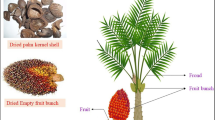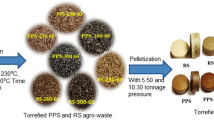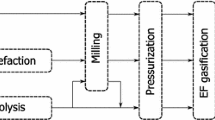Abstract
From the residual biomass generated by the palm oil sector in Ecuador, kernel shell (KS) is of major importance because it has been demonstrated that its use as solid fuel could replace diesel and LPG currently subsidized by the government to be used in the industrial and commercial sectors to produce thermal energy. The implementation of a torrefaction process could improve the KS handling and transportation operations, thus promoting its domestic use. However, the mesocarp fiber (MF) generated in the mills is 2.5 times the amount of KS generated. Therefore, this work analyzes an energy system that could valorize simultaneously MF and KS by the integration of pyrolysis and torrefaction processes, to produce biochar and torrefied fuel. A numerical model is used to analyze the integration of the pyrolysis and torrefaction processes considering a temperature range between 250 and 550 °C. It is observed that biochar and torrefied fuel could be produced simultaneously from pyrolysis process temperatures of 460 °C. The maximum load capacity of the integrated pyrolysis and torrefaction system corresponds to the highest temperature considered 550 °C (1 kg of KS per each kg of MF). However, the highest energy efficiency is found at lower pyrolysis process temperatures, near the auto-thermal operation temperature. The average efficiency of the analyzed energy system is 59.7%. Thus, the use of an integrated pyrolysis and torrefaction system could be an efficient alterative to be applied in small scale mills, to improve the KS energy density and valorize MF into biochar.






Similar content being viewed by others
Abbreviations
- db:
-
Dry basis
- wb:
-
Wet basis
- pg:
-
Pyrolysis gas
- tg:
-
Torrefaction gas
- G:
-
Permanent gas
- R:
-
Reactants
- P:
-
Products
- r:
-
Reaction
- L:
-
Lost
- s:
-
Sensible
- l:
-
Latent
- hr:
-
Heat of reaction
- ch:
-
Char
- t:
-
Tar
- F:
-
Feedstock
- g:
-
Gas
- torr:
-
Torrefaction
- @260 °C:
-
Process occurring at 260 °C
- wt%:
-
Weight percentage (%)
- \({W_{C,F}}\) :
-
Carbon content in the feedstock (kg/kg,F)
- \({W_{H,F}}\) :
-
Hydrogen content in the feedstock (kg/kg,F)
- \({W_{S,F}}\) :
-
Sulfur content in the feedstock (kg/kg,F)
- \({W_{O,F}}\) :
-
Oxygen content in the feedstock (kg/kg,F)
- \({W_{N,F}}\) :
-
Nitrogen content in the feedstock (kg/kg,F)
- \({W_{Z,F}}\) :
-
Ash content in the feedstock (kg/kg,F)
- \({h_{wv,T}}\) :
-
Water enthalpy of vaporization at reference temperature T (J/kgi)
- \(\Delta {H_R}\) :
-
Energy content in the feedstock (MJ/kg,F)
- \(\Delta {H_r}\) :
-
Energy consumed during the carbonization/torrefaction process (MJ/kg,F)
- \(\Delta {H_P}\) :
-
Energy content in the products (MJ/kg,F)
- \(\Delta {H_L}\) :
-
Energy loss during the carbonization/torrefaction process (MJ/kg,F)
- \(\Delta {H_{R,s}}\) :
-
Sensible heat content in the pyrolysis reactants (MJ/kg,F)
- \(\Delta {H_{R,l}}\) :
-
Latent heat content in the pyrolysis reactants (MJ/kg,F)
- \(\Delta {H_{R,hr}}\) :
-
Heat of reaction in the pyrolysis reactants (MJ/kg,F)
- \(T\) :
-
Temperature (°C)
- \({W_{W,F}}\) :
-
Moisture content; mass ratio (kgmoisture/kg,F)
- \(\Delta {H_{P,s}}\) :
-
Sensible heat content in the pyrolysis products (MJ/kg,F)
- \(\Delta {H_{P,l}}\) :
-
Latent heat content in the pyrolysis products (MJ/kg,F)
- \(\Delta {H_{P,hr}}\) :
-
Heat of reaction in the pyrolysis products (MJ/kg,F)
- \({Y_j}\) :
-
Yield of the pyrolytic product “j” (kgj/kg,F)
- \({M_j}\) :
-
Mass of pyrolytic product “j” (kg)
- \(c{p_j}\) :
-
Specific heat of the pyrolytic product “j” (kJ/kg K)
- \({T_j}\) :
-
Temperature of the pyrolytic product “j” (°C)
- \({W_{pg}}\) :
-
Condensable species in pyrolysis gas (kgj/kg,F)
- \({Y_{ch}}\) :
-
Yield of char (kgch/kg,F)
- \({Y_G}\) :
-
Yield of permanent gas (kgG/kg,F)
- \({Y_t}\) :
-
Yield of tar (kgt/kg,F)
- \({W_{C,pg}}\) :
-
Carbon content in the pyrolysis gas (kg/kgpg)
- \({W_{H,pg}}\) :
-
Hydrogen content in the pyrolysis gas (kg/kgpg)
- \({W_{O,pg}}\) :
-
Oxygen content in the pyrolysis gas (kg/kgpg)
- \({W_{N,pg}}\) :
-
Nitrogen content in the pyrolysis gas (kg/kgpg)
- \({W_{S,pg}}\) :
-
Sulfur content in the pyrolysis gas (kg/kgpg)
- \({W_{W,pg}}\) :
-
Pyrolytic water content in the pyrolysis gas (kg/kgpg)
- \({M_C}\) :
-
Molar mass of carbon (kg/mol)
- \({M_H}\) :
-
Molar mass of hydrogen (kg/mol)
- \({M_O}\) :
-
Molar mass of oxygen (kg/mol)
- \({M_N}\) :
-
Molar mass of nitrogen (kg/mol)
- \({M_S}\) :
-
Molar mass of sulfur (kg/mol)
- \({M_W}\) :
-
Molar mass of pyrolytic water (kg/mol)
- \({W_{a,A}}\) :
-
Combustion air (stoichiometric and excess air) (kgair/kgpg)
- \({M_{air}}\) :
-
Molar mass of air (kg/mol)
- \({W_{VA}}\) :
-
Moisture content of combustion air (kgmoisture/kgair)
- \({n_{CO2}}\) :
-
CO2 yield in the flue gas (kmol/kgpg)
- \({n_{H2O}}\) :
-
H2O yield in the flue gas (kmol/kgpg)
- \({n_{O2}}\) :
-
O2 yield in the flue gas (kmol/kgpg)
- \({n_{SO2}}\) :
-
SO2 yield in the flue gas (kmol/kgpg)
- \({n_{N2}}\) :
-
N2 yield in the flue gas (kmol/kgpg)
- \(\Delta {H_{R,C~}}\) :
-
Energy content in the reactants of the combustion process (MJ/kgpg)
- \(\Delta {H_{u,C}}\) :
-
Thermal energy in result of the combustion process (MJ/kgpg)
- \(\Delta {H_{P,C}}\) :
-
Energy content in the products of the combustion process (MJ/kgpg)
- \(\Delta {H_{L,C}}\) :
-
Energy loss during the combustion process (MJ/kgpg)
- \(\Delta {H_{av}}\) :
-
Excess heat (MJ/kg,F)
- \(\Delta {H_i}\) :
-
Heat from external sources (MJ/kg,F)
- \({Y_{pg}}\) :
-
Yield of pyrolysis gas (kg/kg,F)
- \({Y_{tg}}\) :
-
Yield of torrefaction gas (kg/kg,F)
- \({\dot {\text{m}}_{{{torr}}}}\) :
-
Load capacity of the torrefaction process (kg,KS/kg,MF)
- \({n_I}\) :
-
First law efficiency (%)
References
Ministerio de Agricultura Ganadería Pesca y Acuacultura: Diagnóstico de la cadena de la palma aceitera, plan de mejora competitiva. In: Análisis sectorial aceite de palma y elaborados. Ministerio de Agricultura Ganadería Pesca y Acuacultura, Quito (2014)
Fedepalma: Anuario Estadístico 2017: Principales cifras de la agroindustria de la palma de aceite en Colombia 2012–2016. (2017). https://doi.org/10.1017/CBO9781107415324.004
Osei-Amponsah, C., Visser, L., Adjei-Nsiah, S., Struik, P.C., Sakyi-Dawson, O., Stomph, T.J.: Processing practices of small-scale palm oil producers in the Kwaebibirem District, Ghana: a diagnostic study. NJAS—Wageningen J. Life Sci. 60–63, 49–56 (2012). https://doi.org/10.1016/j.njas.2012.06.006
Poku, K.: Small-Scale Palm Oil Processing in Africa. Food and Agriculture Organization of the United Nations, Rome (2002)
Salomón, M.: On the Optimal Use of Industrial Generated Biomass Residues for Polygeneration. KTH School of industrial Engineering and Management, Stockholm (2014)
Ministerio de Electricidad y Energía Renovable: ATLAS Bioenergético de la República del Ecuador. Ministerio de Electricidad y Energía Renovable, Quito (2014)
Ninduangdee., P., Kuprianov., V.: Combustion of palm kernel shell in a fluidized bed: optimization of biomass particle size and operating conditions. Energy Convers. Manag. 85, 800–808 (2014). https://doi.org/10.1016/j.enconman.2014.01.054
Faizal, H.M., Shamsuddin, H.S., Heiree, M.H.M., Hanaffi, M.F.M.A., Rahman, M.R.A., Rahman, M.M., Latiff, Z.: Torrefaction of densified mesocarp fibre and palm kernel shell. Renew. Energy 122, 419–428 (2018). https://doi.org/10.1016/j.renene.2018.01.118
Heredia, M.A.: Cuesco de palma africana, un nuevo combustible para uso comercial en Ecuador: análisis económico y evidencia experimental. In: Revista SOMOS MAGAP (ed.) Ministerio de Agricultura y Ganadería, Quito (2017)
Heredia, M.A., Tarelho, L.A.C., Matos, A., Rivadeneira-Rivera, D.: Palm oil kernel combustion in a prototype furnace in the Ecuadorian sierra region. In: VI Escola de Combustão. Foz do Iguaçu, UNILA (2017)
Heredia, M.A., Tarelho, L.A.C., Matos, A., Robaina, M., Narváez, R., Peralta, M.E.: Thermoeconomic analysis of integrated production of biochar and process heat from quinoa and lupin residual biomass. Energy Policy 114, 332–341 (2018). https://doi.org/10.1016/j.enpol.2017.12.014
Onoja, E., Chandren, S., Razak, F.I.A., Mahat, N.A., Wahab, R.A.: Oil palm (Elaeis guineensis) biomass in Malaysia: the present and future prospects. Waste Biomass Valoriz. (2018). https://doi.org/10.1007/s12649-018-0258-1
Mitschke, T.: Desarrollo de análisis de mercado nacional e internacional de los productos de pellet. GFA Consulting Group GmbH, Quito (2016)
Chen, W.-H., Peng, J., Bi, X.T.: A state-of-the-art review of biomass torrefaction, densification and applications. Renew. Sustain. Energy Rev. 44, 847–866 (2015). https://doi.org/10.1016/j.rser.2014.12.039
Uemura, Y., Omar, W.N., Tsutsui, T., Yusup, S.B.: Torrefaction of oil palm wastes. Fuel 90, 2585–2591 (2011). https://doi.org/10.1016/j.fuel.2011.03.021
Sukiran, M.A., Abnisa, F., Daud, W.M.A.W., Abu Bakar, N., Loh, S.K.: A review of torrefaction of oil palm solid wastes for biofuel production. Energy Convers. Manag. 149, 101–120 (2017). https://doi.org/10.1016/j.enconman.2017.07.011
Garcia-Nunez, J.A., Rodriguez, D.T., Fontanilla, C.A., Ramirez, N.E., Silva Lora, E.E., Frear, C.S., Stockle, C., Amonette, J., Garcia-Perez, M.: Evaluation of alternatives for the evolution of palm oil mills into biorefineries. Biomass Bioenergy 95, 310–329 (2016). https://doi.org/10.1016/j.biombioe.2016.05.020
Qian, K., Kumar., A., Zhang, H., Bellmer, D., Huhnke, R.: Recent advances in utilization of biochar. Renew. Sustain. Energy Rev. 42, 1055–1064 (2015). https://doi.org/10.1016/j.rser.2014.10.074
Scholz, S.M., Sembres, T., Roberts, K., Whitman, T., Wilson, K., Lehmann, J.: Biochar Systems for Smallholders in Developing Countries: Leveraging Current Knowledge and Exploring Future Potential for Climate-Smart Agriculture. The World Bank, Washington, DC (2014)
Lehmann, J., Rillig, M.C., Thies, J., Masiello, C.A., Hockaday, W.C., Crowley, D.: Biochar effects on soil biota—a review. Soil Biol. Biochem. 43, 1812–1836 (2011). https://doi.org/10.1016/j.soilbio.2011.04.022
Liu, N., Zhou, J., Han, L., Ma, S., Sun, X., Huang, G.: Role and multi-scale characterization of bamboo biochar during poultry manure aerobic composting. Bioresour. Technol. 241, 190–199 (2017). https://doi.org/10.1016/j.biortech.2017.03.144
Li, Z., Jia, M., Christie, P., Ali, S., Wu, L.: Use of a hyperaccumulator and biochar to remediate an acid soil highly contaminated with trace metals and/or oxytetracycline. Chemosphere 204, 390–397 (2018). https://doi.org/10.1016/j.chemosphere.2018.04.061
Kutlu, H., Unsal, I., Görgülü, M.: Effects of providing dietary wood (oak) charcoal to broiler chicks and laying hens. Anim. Feed Sci. Technol. 90, 213–226 (2001). https://doi.org/10.1016/S0377-8401(01)00205-X
Kauffman, N., Dumortier, J., Hayes, D.J., Brown, R.C., Laird, D.A.: Producing energy while sequestering carbon? The relationship between biochar and agricultural productivity. Biomass Bioenergy 3, 167–176 (2014). https://doi.org/10.1016/j.biombioe.2014.01.049
Chidumayo, E.N., Gumbo, D.J.: The environmental impacts of charcoal production in tropical ecosystems of the world: a synthesis. Energy Sustain. Dev. 17, 86–94 (2013). https://doi.org/10.1016/j.esd.2012.07.004
Meneghetti, G., Encarnação, F.: The environmental impact on air quality and exposure to carbon monoxide from charcoal production in southern Brazil. Environ. Res. 116, 136–139 (2012). https://doi.org/10.1016/j.envres.2012.03.012
Sparrevik, M., Adam, C., Martinsen, V., Cornelissen, G.: Emissions of gases and particles from charcoal/biochar production in rural areas using medium-sized traditional and improved “retort” kilns. Biomass Bioenergy 72, 65–73 (2015). https://doi.org/10.1016/j.biombioe.2014.11.016
de Oliveira Vilela, A., Lora, E.S., Quintero, Q.R., Vicintin, R.A., Souza, T.P.: A new technology for the combined production of charcoal and electricity through cogeneration. Biomass Bioenergy 69, 222–240 (2014). https://doi.org/10.1016/j.biombioe.2014.06.019
Garcia-Perez, M., Lewis, T., Kruger, C.E.: Methods for Producing Biochar and Advanced Biofuels in Washington State: Literature Review of Pyrolysis Reactors. Washington State University, Pullman (2010)
Basu, P.: Biomass Gasification and Pyrolysis. Elsevier, Burlington (2010)
Rosas, G., Cara, J., Martínez, O.: Slow pyrolysis of relevant biomasses in the Mediterranean basin. Part 1. Effect of temperature on process performance on a pilot scale. J. Clean. Prod. 120, 181–190 (2016). https://doi.org/10.1016/j.jclepro.2014.10.082
Heredia, M., Tarelho, L., Matos, A.: Valoración del calor residual de reactores de pirólisis para la producción combinada de carbón vegetal y combustible torrificado. Rev. Téc. Energ. 12, 396–404 (2016)
Garcia-Nunez, J.A., Ramirez-Contreras, N.E., Rodriguez, D.T., Silva Lora, E.E., Frear, C.S., Stockle, C., Garcia-Perez, M.: Evolution of palm oil mills into bio-refineries: literature review on current and potential uses of residual biomass and effluents. Resour. Conserv. Recycl. 110, 99–114 (2015). https://doi.org/10.1016/j.resconrec.2016.03.022
Garcia-Nunez, J.A., Garcia-Perez, M., Rodriguez, D.T., Ramirez, N.E., Fontanilla, C.A., Stockle, C., Amonette, J.E., Frear, C.S., Silva Lora, E.E.: Evolution of palm oil mills into biorefineries: technical and enviromental assesment of six biorefinery options. In: Biorefinery I: Chemicals and Materials from Thermo-Chemical Biomass Conversion and Related Processes. Elsevier, Oxford (2015)
Neves, D., Thunman, H., Matos, A., Tarelho, L., Gómez-Barea, A.: Characterization and prediction of biomass pyrolysis products. Prog. Energy Combust. Sci. 37, 611–630 (2011). https://doi.org/10.1016/j.pecs.2011.01.001
Neves, D.: Evaluation of Thermochemical Conversion in Fluidized Bed. Universidade de Aveiro, Aveiro (2013)
Alburquerque, A., Mora, S.M.E., Barr, M., Rabanales, V., De, C., Madrid, C.: Slow pyrolysis of relevant biomasses in the Mediterranean basin. Part 2. Char characterisation for carbon sequestration and agricultural uses. J. Clean. Prod. 120, 191–197 (2016). https://doi.org/10.1016/j.jclepro.2014.10.080
Batidzirai, B., Mignot, aP.R., Schakel, W.B., Junginger, H.M., Faaij, A.P.C.: Biomass torrefaction technology: techno-economic status and future prospects. Energy 62, 196–214 (2013). https://doi.org/10.1016/j.energy.2013.09.035
Luthfia, N., Natanael, A., Budiman, S., Budiman, A.: Pyrolysis of palm-oil shell to bio-oil. In: Proceeding the Regional Conference on Chemical Engineering 2014, pp. 1–4 (2015)
Abnisa, F., Arami-Niya, A., Daud, W.M.A.W., Sahu, J.N.: Characterization of bio-oil and bio-char from pyrolysis of palm oil wastes. Bioenergy Res. 6, 830–840 (2013). https://doi.org/10.1007/s12155-013-9313-8
National Institute of Standards and Technology: NIST Chemistry Webbook. U.S. Secretary of Commerce, Gaithersburg (2017)
Tesfaldet, G., Adetoyese, O., Ho, T., Tsz, Y., Yu, Z., Chi, W.: Design and optimization of biomass power plant. Chem. Eng. Res. Des. 2, 1412–1427 (2014)
Lythcke-Jørgensen, C., Haglind, F., Clausen, L.R.: Exergy analysis of a combined heat and power plant with integrated lignocellulosic ethanol production. Energy Convers. Manag. 85, 817–827 (2014). https://doi.org/10.1016/j.enconman.2014.01.018
Kamate, S.C., Gangavati, P.B.: Exergy analysis of cogeneration power plants in sugar industries. Appl. Therm. Eng. 29, 1187–1194 (2009). https://doi.org/10.1016/j.applthermaleng.2008.06.016
Acknowledgements
This work was supported by the Instituto de Fomento al Talento Humano-IFTH and The Republic of Ecuador. The first author acknowledges Gonzalo Mejía from ARMEL-GM for providing data and relevant insights regarding the Ecuadorian palm oil sector. The authors acknowledge the Portuguese Foundation of Science and Technology for the financial support through project PTDC/AAC-AMB/116568/2010 (Project no. FCOMP-01-0124-FEDER-019346)-BiomAshTech—Ash impacts during thermochemical conversion of biomass and project UID/AMB/50017/2013 (CESAM) through national funds, co-funding by the FEDER, within the PT2020 Partnership Agreement and Compete 2020.
Author information
Authors and Affiliations
Corresponding author
Rights and permissions
About this article
Cite this article
Salgado, M.A.H., Tarelho, L.A.C. & Matos, A. Analysis of Combined Biochar and Torrefied Biomass Fuel Production as Alternative for Residual Biomass Valorization Generated in Small-Scale Palm Oil Mills. Waste Biomass Valor 11, 343–356 (2020). https://doi.org/10.1007/s12649-018-0467-7
Received:
Accepted:
Published:
Issue Date:
DOI: https://doi.org/10.1007/s12649-018-0467-7




